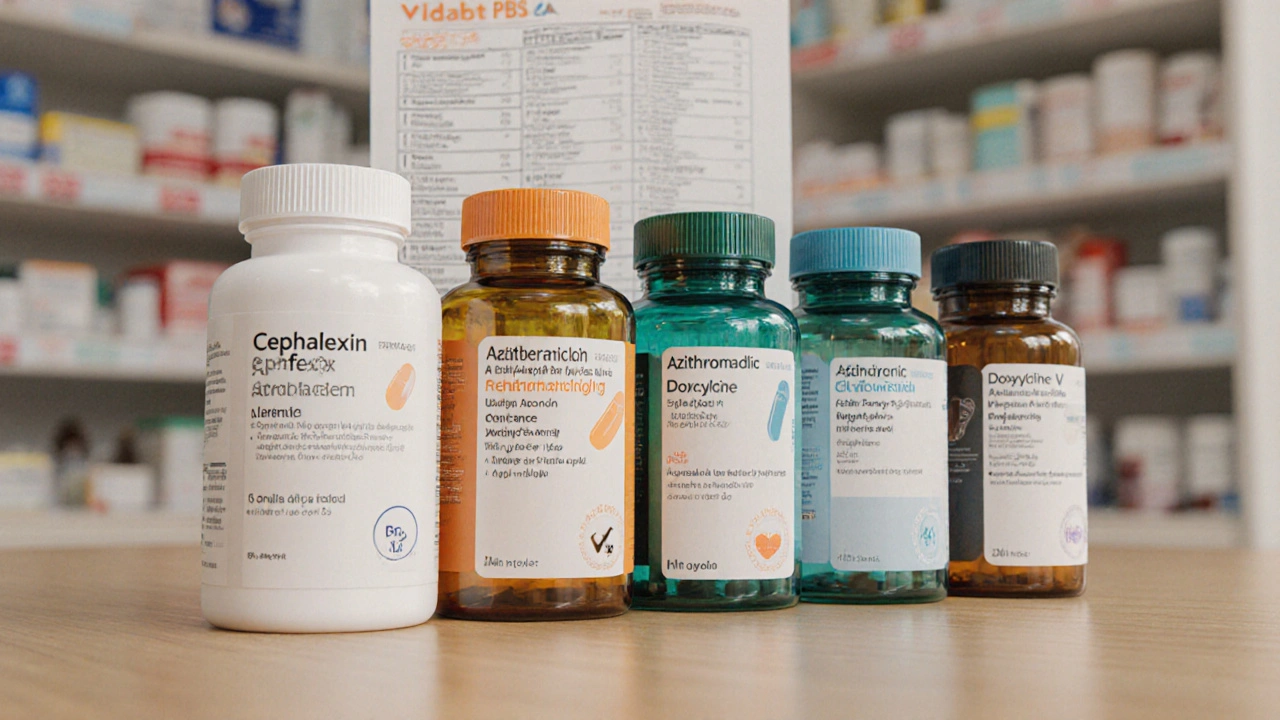
Cephalexin vs. Antibiotic Alternatives Comparison Tool
Recommended Antibiotics Based on Your Selection
Detailed Comparison Table
| Antibiotic | Class | Typical Use | Dosage Form | Side Effects | Cost (AU$) | Pregnancy Safety |
|---|
Key Takeaways
- Cephalexin (Phexin) is a first‑generation cephalosporin ideal for uncomplicated skin and soft‑tissue infections.
- Amoxicillin, azithromycin, clindamycin, doxycycline and penicillin V cover many of the same infections but differ in spectrum, dosing frequency, side‑effect profile and pregnancy safety.
- Cost and insurance coverage in Australia vary widely; generic cephalexin is usually cheapest, while azithromycin and clindamycin can be pricier.
- When choosing an alternative, consider infection type, patient allergies, renal function and pregnancy status.
- Always consult a pharmacist or prescriber before switching - the comparison chart is a guide, not a substitution rule.
Running out of options for a common infection can feel stressful. You’ve probably heard the brand name Phexin and wonder if another pill will work just as well. This article lines up Cephalexin side‑by‑side with the most frequently prescribed alternatives in Australia, so you can see where each one shines and where it falls short.
What is Phexin (Cephalexin)?
Cephalexin is a first‑generation cephalosporin antibiotic that interferes with bacterial cell‑wall synthesis, leading to cell death. Marketed in Australia under the brand Phexin, it is available in 250mg and 500mg tablets, as well as oral suspension for children.
Typical Infections Treated by Cephalexin
Cephalexin works best for uncomplicated infections where Gram‑positive bacteria dominate. Common uses include:
- Skin and soft‑tissue infections (e.g., cellulitis, impetigo)
- Upper respiratory tract infections such as streptococcal pharyngitis
- Urinary tract infections caused by susceptible E. coli
- Bone infections (osteomyelitis) when caused by susceptible organisms
How Cephalexin Works
The drug binds to penicillin‑binding proteins (PBPs) inside bacterial cell walls, preventing the cross‑linking of peptidoglycan chains. Without a sturdy wall, the bacterium bursts under osmotic pressure. This mechanism makes cephalexin especially potent against Staphylococcus aureus (including many methicillin‑sensitive strains) and Streptococcus pyogenes.

Common Alternatives to Cephalexin
Below are the five antibiotics most likely to be suggested when cephalexin isn’t suitable. Each entry includes a micro‑data block for quick reference.
Amoxicillin is a broad‑spectrum penicillin that targets many Gram‑positive and some Gram‑negative bacteria. It is often the first choice for dental infections and otitis media.
Azithromycin belongs to the macrolide class, offering a long half‑life that allows once‑daily dosing for up to five days. It’s popular for atypical respiratory infections.
Clindamycin is a lincosamide antibiotic with strong activity against anaerobes and certain resistant skin pathogens, making it a go‑to for serious cellulitis when MRSA is suspected.
Doxycycline is a tetracycline derivative effective against a wide range of bacteria, including atypical organisms like Chlamydia and Rickettsia. It’s also used for acne.
Penicillin V (phenoxymethylpenicillin) is an older narrow‑spectrum penicillin primarily used for streptococcal pharyngitis and mild skin infections.
Comparison Chart - Cephalexin vs. Alternatives
| Antibiotic | Class | Typical Use | Dosage Form | Common Side Effects | Approx. Cost (AU$) per course | Pregnancy Safety (Australia) |
|---|---|---|---|---|---|---|
| Cephalexin (Phexin) | Cephalosporin | Skin, soft‑tissue, uncomplicated UTIs | 250mg/500mg tablets, oral suspension | GI upset, rash, rare C. difficile | ~$8-$12 for 7‑day course | Category B2 - generally safe |
| Amoxicillin | Penicillin | Dental, otitis media, sinusitis | 250mg/500mg tablets, suspension | Diarrhea, allergic rash, liver enzymes | ~$6-$10 | Category B1 - safe |
| Azithromycin | Macrolide | Atypical pneumonia, chlamydia, travel‑related diarrhea | 250mg tablets, suspension | GI upset, QT prolongation (rare) | ~$15-$22 | Category B2 - safe |
| Clindamycin | Lincosamide | Severe cellulitis, anaerobic infections, MRSA suspicion | 150mg capsules | Diarrhea (C. difficile risk), metallic taste | ~$20-$28 | Category B2 - safe |
| Doxycycline | Tetracycline | Atypical pneumonia, acne, Lyme disease | 100mg tablets | Photosensitivity, GI upset, esophageal irritation | ~$12-$18 | Category D - avoid in pregnancy |
| Penicillin V | Penicillin | Streptococcal pharyngitis, mild skin infections | 250mg tablets | Allergic reactions, GI upset | ~$5-$8 | Category B1 - safe |
When to Stick with Cephalexin
If the infection is limited to skin, bone, or uncomplicated urinary tract and the patient has no known cephalosporin allergy, Phexin remains the most cost‑effective option. Its twice‑daily dosing simplifies adherence compared with three‑times‑daily regimens like amoxicillin.
When an Alternative Might Be Better
- Penicillin allergy: Switch to azithromycin or doxycycline, which have no cross‑reactivity.
- MRSA suspicion: Clindamycin offers better coverage for resistant staph strains.
- Pregnancy concerns: Amoxicillin or penicillin V are preferred for first‑trimester infections; avoid doxycycline.
- Convenient dosing: Azithromycin’s once‑daily schedule can improve compliance for busy patients.
- Cost constraints: Generic cephalexin and penicillin V are the cheapest options in the PBS.
Potential Pitfalls & How to Avoid Them
- Assuming “all antibiotics work the same.” Each class targets a different bacterial spectrum; misuse drives resistance.
- Skipping the full course because symptoms improve. Incomplete treatment can cause relapse and C.difficile infection.
- Ignoring drug‑food interactions. Doxycycline should be taken with water and not right before lying down to avoid esophageal irritation.
- Overlooking renal dose adjustments. Cephalexin and amoxicillin require lower doses in patients with creatinine clearance <30ml/min.
Quick Decision Tree
Use this flow to pick the right drug in a clinic setting:
- If the patient is allergic to penicillins or cephalosporins → consider azithromycin or doxycycline (if not pregnant).
- If MRSA risk is high → choose clindamycin (after confirming susceptibility).
- If cost is the primary concern and infection is uncomplicated skin/soft‑tissue → prescribe cephalexin (Phexin).
- If the patient is in the first trimester of pregnancy → avoid doxycycline; favor amoxicillin or penicillin V.
Frequently Asked Questions
Frequently Asked Questions
Can I take Cephalexin if I’m allergic to penicillin?
Most people with a true penicillin allergy can still tolerate cephalexin because cross‑reactivity is low (about 1‑2%). However, a documented anaphylactic reaction warrants avoidance and using a non‑beta‑lactam like azithromycin.
Why does my doctor sometimes prescribe a 5‑day course of Azithromycin instead of a 7‑day Cephalexin?
Azithromycin’s long half‑life allows a shorter, once‑daily regimen, which improves adherence for certain respiratory infections. The trade‑off is a higher cost and a broader impact on gut flora.
Is it safe to use Cephalexin while breastfeeding?
Yes. Cephalexin passes into breast milk in small amounts and is classified as compatible with breastfeeding by the Australian Therapeutic Goods Administration.
What should I do if I develop a rash while taking Cephalexin?
Stop the medication immediately and contact your pharmacist or prescriber. A rash can indicate a hypersensitivity reaction that may require an alternative antibiotic.
How does the cost of Cephalexin compare to its alternatives in Australia?
Generic cephalexin and penicillin V are the cheapest PBS‑listed options (under $10 for a standard 7‑day course). Azithromycin and clindamycin can exceed $20, while doxycycline sits in the $12‑$18 range.





Geneva Lyra
October 7, 2025 AT 13:30Hey folks, just wanted to point out that Cephalexin (Phexin) is usually the most wallet‑friendly option for uncomplicated skin infections. The generic version often slides under $10 for a full course, which is a big win if you’re watching your budget. It’s also generally considered safe in pregnancy, falling into Category B2 down under Australian guidelines. If you’ve got a mild cellulitis or a simple UTI, give it a try before reaching for the pricier macrolides. Remember to finish the full course – stopping early can invite resistance.
Moritz Bender
October 8, 2025 AT 07:06👍 To add a pharmacokinetic perspective, Cephalexin exhibits a time‑dependent bactericidal activity with a half‑life of approximately 1 hour, necessitating twice‑daily dosing for optimal %T>MIC. This contrasts with azithromycin’s extended half‑life, which permits once‑daily dosing but introduces QT‑prolongation risk in susceptible patients. The lower protein binding of cephalexin (≈10 %) also favors higher free drug concentrations at the infection site. 😊 Consider renal function when dosing; creatinine clearance <30 mL/min warrants a dose reduction.
Nicole Hernandez
October 9, 2025 AT 01:10I appreciate the technical detail here; it helps clarify why a clinician might prioritize Cephalexin for a straightforward skin infection. For patients with a penicillin allergy, though, azithromycin or doxycycline become viable alternatives, provided the pregnancy status is taken into account. It’s also worth noting that patient adherence tends to improve with fewer daily doses, which is why some prescribers lean toward azithromycin despite its higher cost. Ultimately, the choice should balance microbial coverage, safety profile, and practical considerations such as cost and dosing convenience.
florence tobiag
October 9, 2025 AT 19:13Hold on a second!!!; why are we all so quick to accept the "official" comparison without questioning the underlying data sources???; The table presented looks polished, but where is the disclosure of manufacturer sponsorship???; Are we sure the cost figures reflect real‑world pharmacy pricing, or are they just manufacturer suggested retail prices???; And what about hidden variables like regional formulary restrictions, which can dramatically alter out‑of‑pocket expenses???; Plus, the safety categories quoted are based on outdated Australian classifications – many of those have been revised in recent years!!!; If you’re a savvy patient, you should demand more transparency on the methodology used to generate these recommendations!!!; Also, the emphasis on cost‑consciousness seems tailored to PBS policy rather than individual patient needs!!!; Let’s not forget that antibiotic stewardship is paramount – over‑reliance on any single agent, even an inexpensive one, can foster resistance!!!; In short, take the chart with a grain of salt, cross‑reference with up‑to‑date clinical guidelines, and discuss individual circumstances with your prescriber!!!; The bottom line: no single table can replace a personalized medical assessment.
Terry Washington
October 10, 2025 AT 13:16Enough of the hedging – the data is crystal clear: Cephalexin outperforms the rest in cost‑efficacy for uncomplicated infections, period.
Claire Smith
October 11, 2025 AT 07:20I must interject: while cost is a factor, the primary concern should always be appropriate antimicrobial coverage. If a pathogen is resistant to first‑generation cephalosporins, the cheapest option becomes moot. Moreover, the table omits the crucial fact that clindamycin carries a higher risk of C. difficile infection, a severe complication that outweighs any marginal cost savings. Therefore, prescribing decisions must be guided by susceptibility data whenever possible.
Émilie Maurice
October 12, 2025 AT 01:23Look, the blunt truth is that many of these guidelines are written by people who never had to pay for a prescription out of pocket. They throw around "generic" and "PBS" like it’s a universal solution, ignoring that in some regions insurance coverage is non‑existent. If you’re truly cost‑conscious, you’d compare pharmacy price‑checking apps, not just a static table. Also, the safety categories don’t account for individual allergic histories – a "Category B2" drug could still cause severe reactions in a sensitized patient. Bottom line: research beyond the chart.
Ellie Haynal
October 12, 2025 AT 19:26Honestly, the drama around "which antibiotic is best" often feels overblown. Most of the time, any of the listed agents will clear a mild infection if taken correctly. The real issue is patient compliance – missing doses is what drives resistance, not the choice between amoxicillin and cefalexin. So, pick what you can afford and remember to finish the whole course. No need to turn this into a battlefield.
Jimmy Gammell
October 13, 2025 AT 13:30Great points, everyone! 😊 Just a reminder that if you’re unsure which antibiotic fits your situation, a quick chat with your pharmacist can save you a lot of guesswork. They can also help you explore any generic discounts or switch programs available locally.
fred warner
October 14, 2025 AT 07:33Exactly! Staying informed and keeping the lines of communication open with healthcare providers is the best strategy. It’s all about making the right choice for your health while keeping costs reasonable.
Veronica Mayfair
October 15, 2025 AT 01:36💡👍 And don’t forget to check out your local pharmacy’s loyalty program – you might snag a discount on that 7‑day course of Cephalexin! 🌟
Rahul Kr
October 15, 2025 AT 19:40Always read the label.